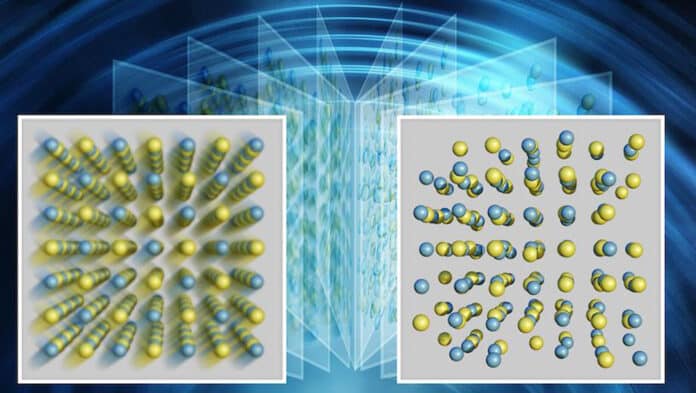Cubic energy materials such as thermoelectrics or hybrid perovskite materials are often understood to be highly disordered. In GeTe and related IV–VI compounds, this is thought to provide the low thermal conductivity needed for thermoelectric applications.
Since conventional crystallography cannot distinguish between static disorder and atomic motions, researchers at Columbia Engineering and Université de Bourgogne have developed a new kind of “camera” that can see the local disorder.
Its striking feature is a variable shutter speed. Because the disordered atomic clusters are moving, the dynamic disorder was veiled when the team used a slow shutter but was visible when they used a quick shutter. The new technique, known as variable shutter PDF or vsPDF (for atomic pair distribution function), differs from conventional camera in that- it measures atomic positions with a shutter speed of about one picosecond, or a million (a trillion) times faster than typical camera shutters. It uses neutrons from a source at the Oak Ridge National Laboratory (ORNL), a facility of the U.S. Department of Energy.
Simon Billinge, professor of materials science and applied physics and mathematics, said, “It’s only with this new vsPDF tool that we can see this side of materials. It gives us a whole new way to untangle the complexities of what is happening in complex materials, hidden effects that can supercharge their properties. With this technique, we’ll be able to watch a material and see which atoms are in the dance and which are sitting it out.”
The researchers identified broken atomic symmetries in GeTe, a crucial material for thermoelectricity, which transforms waste heat to energy, using the vsPDF technique (or electricity into cooling). The displacements and the dynamic changes and how quickly they fluctuated had not been visible before.
The team created a new hypothesis that explains how such local fluctuations can emerge in GeTe and related materials as a result of the discoveries from vsPDF. Researchers can find new materials with these properties and apply outside factors to affect the result, creating even better materials with a mechanistic understanding of the dance.
The next step involves making his technique easier for the research community and applying it to other systems with the dynamic disorder. Currently, the technique is not turn-key, but with further development, it should become a much more standard measurement.
Journal Reference:
- Kimber, S.A.J., Zhang, J., Liang, C.H., et al. Dynamic crystallography reveals spontaneous anisotropy in cubic GeTe. Nat. Mater. 22, 311–315 (2023). DOI: 10.1038/s41563-023-01483-7
